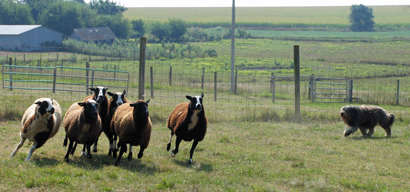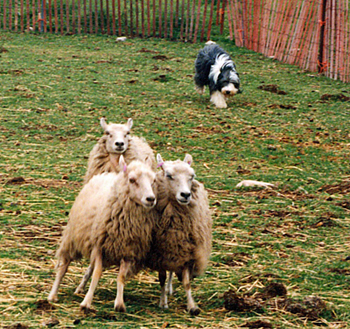
Getting Started in Herding
by Lois Gaspar
Common phrases that are heard are
"I don't know where to begin" or "How do I get started?"
In order to begin training your beardie in herding it is important to understand a few basic concepts, such as herding instinct, the importance of your relationship with your Beardie and the beginning stages of training. You should also learn the vocabulary of herding. The purpose of this article is to whet your appetite to learn more on your own through the variety of resources available. It is not intended as a step by step procedure to train your dog.
Herding Instinct
Your Beardie has demonstrated herding instinct at an Instinct Test. What does this mean to you and your Beardie? It is important to understand the herding instinct. Herding stock is not based on the dog's "love" for the stock ( a common misconception).
Mari Taggart (1991, p.4) states
"the most commonly accepted theory is that a dog-like animal first became man's friend . . . Then, gradually, the dog participated in the hunt and man saw that the dog's help made things easier . . . It was likely that the faster dogs would outrun the hunted animals, circling in front of them to slow them down or turn them back so that man could kill them.
We can stop right here as far as herding instinct is concerned, for this is what has formed the (albeit crude) basis for today's herding instinct."
Therefore, we must remember that herding instinct is derived from the dog's instinct to hunt - the prey drive. His pack instinct gives him the desire to work with you (the pack leader) while doing so. Livestock also respond instincts when they were prey and move away from a dog that approaches them. It is important for us to remember that once we have awakened our Beardie's herding instinct we have awakened an instinct that is based on the prey drive.
It should not be surprising then that your dog may attempt to bite stock, especially if you are reaching for the animal - after all, the instinct is based on the dog bringing the animal to the human to kill. It is important to be prepared for this eventuality, but do not tolerate it. Training is important to overcome this instinctive behaviour. Taggart (1991, p.5) states "Shepherds throughout history have believed any dog, even the best sheepdogs, will kill livestock, given the right circumstances."
The Relationship
This brings me to the second point to understand about herding. When herding, the dog controls the stock, but YOU control the dog. Herding is teamwork between the dog and the handler where the relationship between the dog and the handler is important. Taggart (p.30) states "No dog will give its best to a stranger, or even a family member that it doesn't consider its master. Dogs must be strongly attached to their trainer. They must love and respect the trainer - qualities that will deepen and be enhanced as training proceeds. Some breeds will only work for their "love object" and the rest of the world can take a hike. Get to know your dog and help him love and respect, not fear, you ...you'll be expecting unusual obedience from your dog. There is no way you can MAKE a dog stop at one half mile away; he must want to do so to please you."
Training
Virgil Holland (pp. 9-10) describes herding as "envisioning the handler as the 'coach' and the dog as the 'player'. You send in the signal and immediately the dog responds. At the same time, your dog must independently think how best to carry out the command, relying on natural ability . . . They must instantly react to a signal and then re-enter their instinctive world . . . "
This description is the goal we strive to achieve in our training: we give a command (the correct/appropriate one!); our Beardie responds (appropriately!) to the command; the task is accomplished (correctly!) - all of this being done in a calm manner! While the thought of all of this happening may boggle the minds of many Beardie owners (a Beardie being calm around sheep seems to boggle the minds of some), let me assure that this can be done and this goal can be achieved. However, it will take training to achieve.

Beginning to Train for Herding
Remember that herding is a controlled activity, not a wild frenzy of activity. It is important that your Beardie be responsive to certain commands even before you take him for a first training session on stock. Just as with all training for a Beardie, this training must be fun - not just a boring repetition of commands and responses. Before taking your dog to stock, be sure that the dog has a reliable STOP and a reliable RECALL. When herding, the stop may be a stand, sit or down. Generally young, keen dogs should be taught to "down" since they don't usually stop when standing. As training progresses and the dog becomes more reliable and comfortable with its role with stock, you can move to a stand for the stop. Many herders use the command "there" to indicate to the dog that he is to stop and stand.
It is not my intent to give detailed instructions about teaching your Beardie a "down" or "come". This information is available from many sources and is fundamental learning in any training class. What I would like to stress is the importance of knowing your Beardie and understanding your Beardie Know how to read your dog. Knowing when to "push" your dog and knowing when to "ease off" contribute to successful training. This is no different in training for herding as it is in training for other activities. Being able to read your Beardie properly leads to the trust of your Beardie which is one side of the trust relationship that is essential for successful herding. The other side of the relationship is your Beardie's trust in you - that you will give the correct command at the correct time.
So, as we move into fall and winter (ugh!), our thoughts about herding need not be put on hold until spring. We can work on our STOP and RECALL. We can make these commands reliable at home, in the park, outside the mall .... wherever; so that in the spring we can get into that pen with stock. Remember that you must also have a counter-command for the stop - a command which will release the dog from the stop. You will also learn commands to send your dog away from you after a recall; the command will depend on what will be done next.
Equipment
There is not a lot of equipment needed to train herding. A 5 foot bamboo pole (preferably green bamboo) or if this is not available, a piece of ½ inch PVC piping will do the trick. While a shepherd's crook looks wonderful, it is very heavy for training purposes and if your dog runs into it, the dog could be injured. A flat buckle collar that will not slip over the dog's head is needed as well as a 15 - 20 foot woven training line. The long line should be used only by someone who knows how to handle it since long lines can become tangled and cause injury to dog, sheep or handler. Some trainers also train the dog to respond to a whistle. Do not use a silent whistle or a police-type whistle (your eardrums will pay!!). A common plastic whistle will do.
Oh yes, you also need sheep and a field.

Glossary of Herding Terms and Commands
Balance:
the correct positions of the dog, stock and handler relative to each other.
Dog-broke:
stock that is accustomed to being worked with dogs.
Driving:
moving stock from behind and away from the handler.
Fetch:
bringing the stock to the handler from some distance away, preferably in a straight line.
Gathering:
moving stock towards the handler from the opposite side of the stock.
Grip:
a nip or bite when needed or on command; used to move stubborn stock.
Lift:
moving the stock off the fence or the initial movement of the stock towards the handler.
Loose-eyed:
a dog that works upright and does not keep eye contact with the stock at all times.
Strong-eyed:
a dog that works by staring at the stock.
Outrun:
when the dog is sent out some distance to the opposite side of the stock to gather them to the handler. Usually the outrun is a semi-circular or pear shaped path.
Penning:
moving the sheep into a pen or holding area.
Shedding:
separating one (shedding) or more (splitting) stock from the rest.
Sides: the direction the dog is to go: clockwise or counter clockwise.
Wearing:
the action of the dog moving side to side in a short arc to move the stock.
"Lie down":
used as a stop command to drop the dog on a prone position. This may be replaced later in training by "there", "stand" "stand, stay" or "stay" to have the dog stop on his feet in a standing position.
"Stay":
tells the dog not to move from its stopped position until a counter-command is given.
"Walk up":
used to move the dog straight towards the stock. Other terms which may be used are: "Walk in" and "Go in".
"Easy":
used to tell the dog to approach the stock or move around the stock more slowly. Other terms which are used for this: "steady", "take time" or "time".
"Come Bye":
used to direct the dog to swing in a clockwise direction around the stock. The term "Go bye" is also used for this action. This clockwise movement is also referred to as being "off the left hand" of the handler (Holland, p.23)
"Away To Me:
used to direct the dog in a counter-clockwise direction around the stock. The term "Way to Me" is also used. This counter-clockwise movement is also referred to as being "off the right hand" of the handler (Holland, p.23).
"Look Back":
If the stock has split and the handler wants the dog to go farther from the handler to gather stock the dog may not see.
"Get Back":
used to remind the dog to stay the proper distance away from the stock.
"Get Out":
used if the dog is very close to the stock, splitting stock, diving to pull wool... This command is considered a reprimand.
"That'll Do":
This is the last command and can be considered as "Good job, old boy; now come here and we'll go to the house and get a treat for you". It should be an absolute call off. (Witte, 1991, p.38)
References:
Holland, Vergil S. (1994).
Herding dogs progressive training. New York: Howell Book House
Taggart, Mari. (1991).
Sheepdog training an all-breed approach. Loveland, CO: Alpine Publications.
Witte, Ann Alder. (1991).
Huntaway herding (building biddable Beardie bounce) .
Copyright © 1997-2023 [Lois Gaspar].
All rights
reserved
